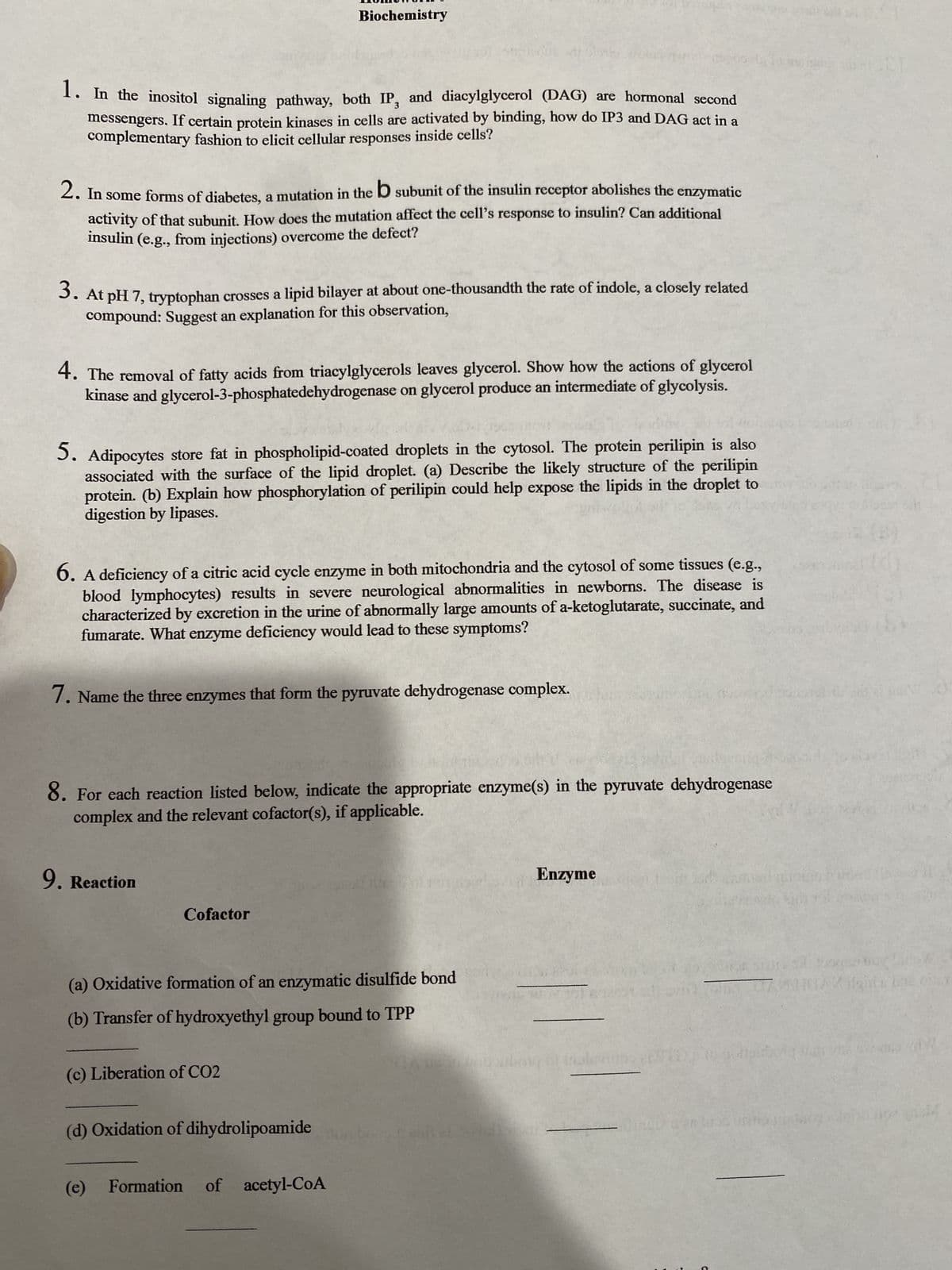8. For each reaction listed below, indicate the appropriate enzyme(s) in the pyruvate dehydrogenase complex and the relevant cofactor(s), if applicable. 9. Reaction Enzyme Cofactor (a) Oxidative formation of an enzymatic disulfide bond (b) Transfer of hydroxyethyl group bound to TPP (c) Liberation of CO2 an tut o (d) Oxidation of dihydrolipoamide (e) Formation of acetyl-CoA
8. For each reaction listed below, indicate the appropriate enzyme(s) in the pyruvate dehydrogenase complex and the relevant cofactor(s), if applicable. 9. Reaction Enzyme Cofactor (a) Oxidative formation of an enzymatic disulfide bond (b) Transfer of hydroxyethyl group bound to TPP (c) Liberation of CO2 an tut o (d) Oxidation of dihydrolipoamide (e) Formation of acetyl-CoA
Biology: The Dynamic Science (MindTap Course List)
4th Edition
ISBN:9781305389892
Author:Peter J. Russell, Paul E. Hertz, Beverly McMillan
Publisher:Peter J. Russell, Paul E. Hertz, Beverly McMillan
Chapter6: Energy, Enzymes, And Biological Reactions
Section: Chapter Questions
Problem 1ITD
Related questions
Question
Question 8 and 9. It is one question just misnumbered

Transcribed Image Text:Biochemistry
1. In the inositol signaling pathway, both IP, and diacylglycerol (DAG) are hormonal second
messengers. If certain protein kinases in cells are activated by binding, how do IP3 and DAG act in a
complementary fashion to elicit cellular responses inside cells?
2. In some forms of diabetes, a mutation in the D subunit of the insulin receptor abolishes the enzymatic
activity of that subunit. How does the mutation affect the cell's response to insulin? Can additional
insulin (e.g., from injections) overcome the defect?
J. At pH 7, tryptophan crosses a lipid bilayer at about one-thousandth the rate of indole, a closely related
compound: Suggest an explanation for this observation,
4. The removal of fatty acids from triacylglycerols leaves glycerol. Show how the actions of glycerol
kinase and glycerol-3-phosphatedehydrogenase on glycerol produce an intermediate of glycolysis.
5. Adipocytes store fat in phospholipid-coated droplets in the cytosol. The protein perilipin is also
associated with the surface of the lipid droplet. (a) Describe the likely structure of the perilipin
protein. (b) Explain how phosphorylation of perilipin could help expose the lipids in the droplet to
digestion by lipases.
6. A deficiency of a citric acid cycle enzyme in both mitochondria and the cytosol of some tissues (e.g.,
blood lymphocytes) results in severe neurological abnormalities in newborns. The disease is
characterized by excretion in the urine of abnormally large amounts of a-ketoglutarate, succinate, and
fumarate. What enzyme deficiency would lead to these symptoms?
EGO
7. Name the three enzymes that form the pyruvate dehydrogenase complex.
8. For each reaction listed below, indicate the appropriate enzyme(s) in the pyruvate dehydrogenase
complex and the relevant cofactor(s), if applicable.
9. Reaction
Enzyme
Cofactor
(a) Oxidative formation of an enzymatic disulfide bond
(b) Transfer of hydroxyethyl group bound to TPP
(c) Liberation of CO2
(d) Oxidation of dihydrolipoamide
(e) Formation
of acetyl-CoA
Expert Solution
This question has been solved!
Explore an expertly crafted, step-by-step solution for a thorough understanding of key concepts.
This is a popular solution!
Trending now
This is a popular solution!
Step by step
Solved in 2 steps

Knowledge Booster
Learn more about
Need a deep-dive on the concept behind this application? Look no further. Learn more about this topic, biochemistry and related others by exploring similar questions and additional content below.Recommended textbooks for you

Biology: The Dynamic Science (MindTap Course List)
Biology
ISBN:
9781305389892
Author:
Peter J. Russell, Paul E. Hertz, Beverly McMillan
Publisher:
Cengage Learning

Biochemistry
Biochemistry
ISBN:
9781305577206
Author:
Reginald H. Garrett, Charles M. Grisham
Publisher:
Cengage Learning

Biology 2e
Biology
ISBN:
9781947172517
Author:
Matthew Douglas, Jung Choi, Mary Ann Clark
Publisher:
OpenStax

Biology: The Dynamic Science (MindTap Course List)
Biology
ISBN:
9781305389892
Author:
Peter J. Russell, Paul E. Hertz, Beverly McMillan
Publisher:
Cengage Learning

Biochemistry
Biochemistry
ISBN:
9781305577206
Author:
Reginald H. Garrett, Charles M. Grisham
Publisher:
Cengage Learning

Biology 2e
Biology
ISBN:
9781947172517
Author:
Matthew Douglas, Jung Choi, Mary Ann Clark
Publisher:
OpenStax